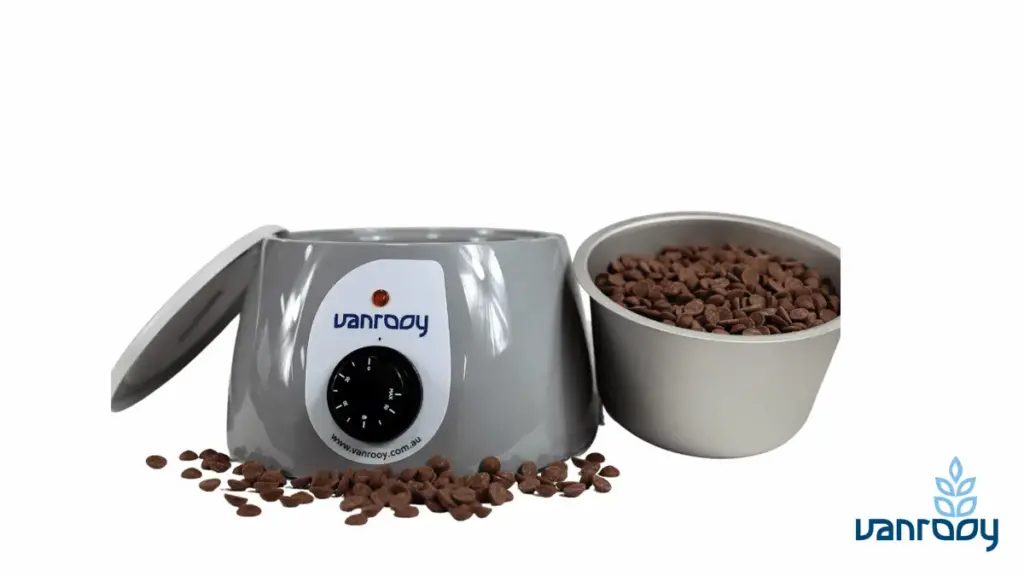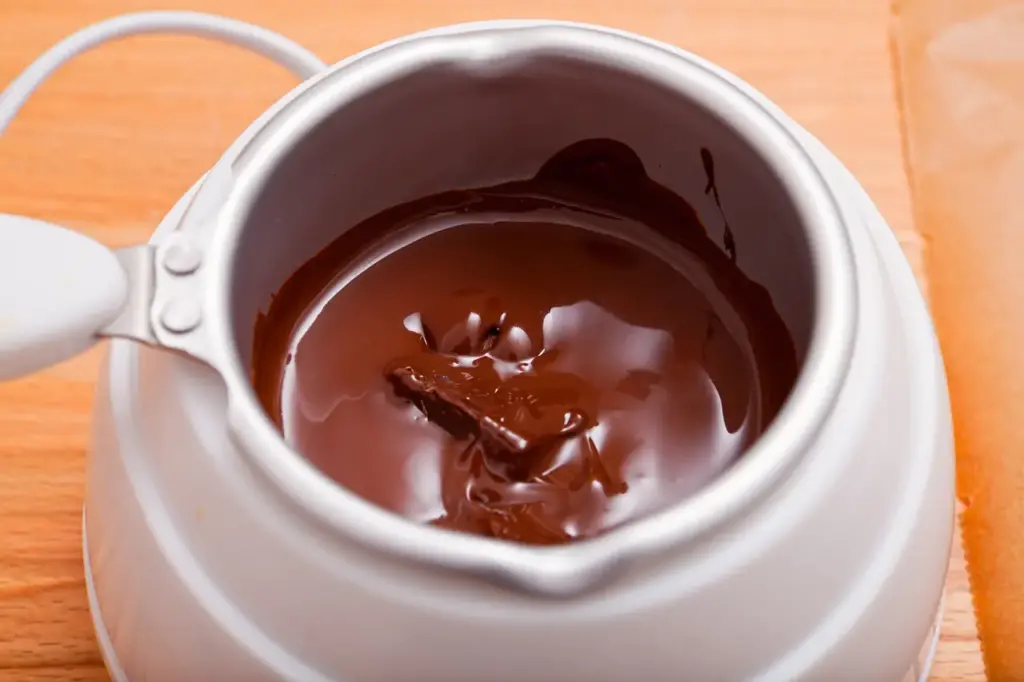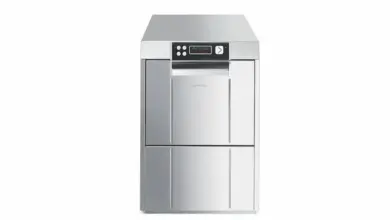Chocolate Melting Pots
Chocolate Melting Pots
Chocolate is a beloved ingredient used worldwide in baking, confections, sauces, desserts, and more. When handled properly, chocolate can transform from bite-size pieces into a smooth, lush, flowing liquid.
However, melting chocolate requires care and mastery. Using improper tools or techniques can result in thick, blobby chocolate or, worse, scorched chocolate that becomes grainy and unusable.
Investing in quality chocolate melting pots equips home cooks with the ideal vessels for glossy melted chocolate every time.
Premium melting pots help achieve the liquid chocolate bliss that makes dessert dreams come true. Paired with proper storage solutions and quality chocolate, these vessels unlock the secrets to fountain-worthy chocolate magic at home.

What is the Best Option for Melting Chocolate?
Without question, the best approach for melting any type of chocolate is using a double boiler method. This delicate yet effective two-pot heating system allows the chocolate to gradually shift from a solid to a liquid state without risks of scorching.
A double boiler setup involves two pans. The bottom stainless steel pot holds a few inches of gently simmering water. Suspended closely above is a second smaller tempered glass or stainless steel bowl safely nestled over the steam.
As the hot humidity transfers warmth upward, the steam slowly heats the top vessel, allowing the chocolate inside to melt gradually. This water bath concept keeps temperatures uniform, protecting delicate chocolate from burning on direct heat while efficiently liquefying it.
The result is beautifully smooth fluid chocolate that is ready for recipes. Glass and stainless double boilers designed specifically for melting chocolate produce exceptional results compared to makeshift household double boilers.
Their durable yet gentle materials distribute heat evenly across bottoms and sides. This facilitates an efficient melt while the transparent glass walls provide visibility to monitor progress without temperature fluctuations from lifting lids. Specialized tools maximise control for luscious melted chocolate.
What is the Best Utensil for Melting Chocolate?
When selecting pots and pans for melting chocolate, specialized chocolate melting tools are ideal. Quality chocolate melters are crafted from heat-conductive yet gentle materials like tempered glass and brushed stainless steel.
These materials allow effective warmth transferral to transform solid chocolate into a flawlessly smooth liquid. Compared to materials like plastic that retain odors, glass, and steel facilitate faster, safer melting.
In addition to smart material construction, the best chocolate melting pots boast features that optimize convenience. Curved interior bottoms increase liquid chocolate contact with flat surfaces for efficient heating.
Easy-pour spouts neatly guide melted chocolate outward with no messy drips. Silicone handles provide a steady grip while staying cool for safety.
Double boiler sets may also include accessories like candy thermometers and stirring paddles. These user-centric additions make melting chocolate easy and enjoyable.
Top brands such as Ovalware, MELUNA, and ZenChef produce specialized chocolate melting pots that deliver delectable results across recipes, decorations, and confections. When equipment meets chocolate in optimized vessels, sweet success flows.

What Chocolate Bars Melt Best?
While technically any chocolate can melt, not all types liquefy ideally. The best quality chocolate for smooth, flawless melting contains ample pure cocoa butter. This naturally occurring saturated fat allows the chocolate to shift between solid and liquid states with ease.
Full-bodied dark, milk, or white chocolate bars boasting higher cacao percentages typically melt more evenly than cheap chocolate-flavored confections.
Premium couverture and baking chocolate from renowned makers like Lindt, Ghirardelli, Valrhona, and Callebaut make exceptional melting candidates thanks to carefully formulated ratios of cocoa solids, cocoa butter, and sugars.
Their indulgent ingredients transition from solid bars to glossy dipping consistency, free of separation or thickening issues. Quality chocolate chips formulated for baking also melt smoothly thanks to sufficient cocoa butter levels.
In contrast, compound chocolate coatings and mass-produced candy products demonstrate less desirable melting behaviors due to inadequate cocoa butter. These imitation chocolates contain vegetable oil substitutes that compromise fluidity when melted.
Typically melting inconsistently, cheaper chocolate rapidly shifts between soupy and seized textures rather than maintaining creamy fluidity. The result is disappointing graininess, which is unsuitable for luscious chocolate cakes or fountain dipping. For happiness when melting matters, do not settle for chocolate imposters.
How do you Melt Chocolate like a Pro?
Transforming quality chocolate into crave-worthy liquid luxury relies first on selecting superior ingredients containing at least 30% cocoa butter.
Chop the chocolate into uniform 1-inch pieces so the smaller size melts quickly. For extra fluidity, incorporate 1 tablespoon of flavorless vegetable shortening per 6-8 ounces of chocolate to supplement cocoa butter levels.
The right equipment is equally essential for professional results. A double boiler set with brushed stainless and tempered glass bowls sized appropriately maximizes control and visibility when melting small batches.
Nestle the top bowl holding chopped chocolate pieces over gently simmering water in the bottom pan.
Pay close attention, using a heat-safe silicone spatula to stir chocolate as the exterior portions begin melting. Carefully yet continuously fold melted areas into remaining solid chunks until completely smooth.
Using an accurate digital candy/chocolate thermometer confirms the ideal fluid thickness for recipes at hand. For basic coating or dipping, heat dark chocolate from 88-90°F (31-32°C) or milk/white chocolate between 86-88°F (30-31°C).
To optimize shine and thickness for decorating intricacies or molding bonbons, heat all chocolate types from 90-92°F (32-33°C). Exceeding these precise temperature thresholds risks scorching and seizing delicate chocolate.
Proper tools coupled with thermometer-guided vigilance empower professionals to create decadent chocolate delicacies every time.
Is Lindt Chocolate Good for Melting?
World-renowned for luxurious Swiss quality, Lindt chocolate is celebrated by home cooks and master chocolatiers alike for melting silky smooth.
Crafting indulgent chocolate confections since 1845, Lindt’s signature pure chocolate bars, truffles, baking discs, and chips contain carefully formulated concentrations of premium ingredients like cocoa butter.
This allows their chocolate to melt evenly into delicious drizzles, luscious desserts, or chocolate creations of any kind without compromising on rich flavors and decadent mouthfeel.
Both Lindt’s divine 85% dark chocolate and their signature milk chocolate transform beautifully from solid bars into glistening liquid thanks to Lindt’s mastery of chocolate making.
Their various Excellence and Creation brands retain indulgent textures when melted using proper double boiler methods, making their melted chocolate shine in all recipes.
Dessert Bars in Dark Chocolate melt into fudge sauce perfection, while White Chocolate Truffle Bars liquefy into stunning white chocolate ganache. With balanced flavors and smooth compositions, melted Lindt chocolate makes taste buds rejoice.
While Lindt’s holiday candies contain vegetable oil and corn syrup solids suited for direct snacking, their pure chocolate ranges without alternate fats provide superior melting quality for all chocolate goals.
Savoring melted Lindt chocolate is a delicious way to experience chocolate decadence in its ultimate fluid form.
Does Cadbury Chocolate Melt Well?
Sweet memories of British chocolate quality come to life melted smooth in Cadbury bars that charm chocolate cravings across Australia.
Their traditional Cadbury Dairy Milk chocolate and premium dark chocolate blends melt deliciously into recipes thanks to carefully crafted cocoa butter content.
The classic Cadbury Milk Chocolate bar contains over 35% milk for flavors reminiscent of sweet cream. This original formula melts indulgently into soul-soothing cups of hot chocolate, silky fudge sauce ganache for desserts, or velvety frostings crowning cakes and cupcakes.
Meanwhile, Cadbury Old Gold Dark and Cadbury Dark Milk bars showcase a richer 70% cocoa punch mellowed by milk’s sweetness on the palate.
These complex chocolates combine to deliver melted chocolate, perfect for glazing tarts or folding into cookie batter for chocolate chunk heaven.
As one of the world’s most recognized chocolate brands for over a century, genuine Cadbury chocolate made from all-natural ingredients is specially formulated to melt smoothly without any undesirable graininess or thickening.
Their traditional Dairy Milk and organic Dark Milk bars with at least 30% cocoa butter content excel in melted applications, whether stirring spoonfuls into pancake batter or pouring elegantly over ice cream.
With real cocoa extracts shining through, Cadbury chocolate melts make chocolate creations that allure the senses and great desserts that satisfy the soul.
Tips for Storing Melted Chocolate
Properly storing melted chocolate maintains perfect fluidity for hours. Allowing liquid chocolate to harden prematurely ruins dipping, drizzling, and decorating projects. Follow these expert tips:
Maintain Optimal Temperature
Preserving melted chocolate’s liquid state starts with keeping the confection between 85-87°F (29-31°C). Nestle the sealed bowl over a folded kitchen towel laid atop a simmering water bath. The residual warmth prevents premature hardening without risking overheating.
Transfer melted chocolate into a thermos flask designed for temperamental liquids like gravies or custards for maximum longevity. The insulated walls retain heat for 8+ hours, allowing fluid chocolate whenever inspiration strikes.
Add Liquid
Incorporate 1-2 tablespoons of heavy cream, flavor extract, or vegetable oil per cup of melted chocolate. Adding liquid slows crystallization, allowing chocolate to remain pourable longer. Agitate the mixture occasionally to maintain a smooth, homogenous emulsion.
Prevent Contact with Moisture
Even minute water exposure causes melted chocolate to seize up. Ensure all equipment and ingredients contacting liquid chocolate are meticulously dry. Choose solid foods like fruit or pound cake for dipping over moist ingredients like marshmallows.
Work in environments below 65% humidity and avoid direct sunlight on melted chocolate. Always wipe bowl rims before covering to prevent condensation from hardening liquid chocolate.
With vigilance protecting chocolate from moisture, luscious dipping and drizzling continue uninterrupted.
Types of Chocolate Melting Pots
When ready to melt, numerous styles of chocolate melting vessels are available to match diverse needs and budgets. Consider options like:
Double Boiler Sets
Complete double boiler kits provide efficient chocolate liquefying with matching bowls and sauce pots ready for steaming.
Affordable stainless steel all-in-one sets like those from Ovalware or ZenChef include handy silicone-tipped accessories like spoons, ladles, and candy thermometers.
Unlike glass vessels, stainless steel transfers heat quickly but does not allow clear visibility when monitoring the melting process.
Glass Bowls
Specialty-tempered borosilicate glass bowls promote better observation through transparent walls. Brands like MELUNA design their glass chocolate melting pitchers with spouts for tidy pouring and handy handles for safe grip even when hot.
The durable glass construction resists staining and uneven hotspots. Glass evenly distributes warmth while heating rapidly. Just take care not to place extremely cold glass into hot water baths.
Electric Fondue Pots
Self-contained tabletop electric appliances offer unique hands-free operation. However, the indirect heating elements in most electric chocolate fondue fountains can scorch chocolate without built-in agitation. Ensure any electric melters have precisely adjustable thermostats, nonstick interiors, and paddle stirrers to prevent burning.
Melting Chocolate for Special Diets
The heavenly experience of fluid chocolate should be safe for everyone to savor. When managing food allergies, sensitivities, or diet preferences like veganism, verify all ingredients meet specific dietary guidelines before melting and consuming.
Dairy-Free
Full cacao percentage dark chocolate bars already naturally exclude milk ingredients. Explore using canned coconut cream, almond milk, or oat milk condensed with sugar to thin dark chocolate to creamy textures perfect for frostings and beverages.
Gluten-Free
Carefully vet chocolates, ensuring brands clearly state gluten-free status on the packaging.
Some specialty producers make gluten-free claims based on ingredients alone, but cross-contamination risks from shared factory equipment remain concerning for celiac disease patients. Establish chocolate purity by contacting manufacturers directly before consuming.
Keto
The high-fat, low-sugar nature of dark chocolate aligns beautifully with ketogenic diet guidelines. Focus on selecting ultra-low net carb, full cacao percentage dark chocolate without added sugars.
Include keto-approved peanut butter, almond butter, or MCT oil to thin melted dark chocolate into thick, lush syrups perfect for desserts.
Vegan
Some specialty chocolate companies craft plant-based chocolate by replacing dairy-based cocoa butter with alternate vegetable fats like non-hydrogenated palm oil or coconut oil.
Additionally, semi-sweet and bittersweet baking chocolate discs marked vegan offer accessibility. Explore these compassionate chocolate options for sensational vegan sweets.
Proper Use and Care for Chocolate Melting Pots
Caring properly for chocolate melting pots preserves functionality and longevity. Handwash vessels gently after each use with warm, soapy water. For stubborn residue, fill pots with hot water and dissolve a spoonful of baking soda, then scrub gently with a soft brush.
Avoid harsh detergents or metal utensils that could scratch surfaces. Dry thoroughly with soft towels, ensuring no moisture hides in crevices.
Store pots with lids in cool, dry places away from heat or sunlight exposure. With regular gentle cleaning and dry storage, quality chocolate melting pots deliver years of smooth melting.
Troubleshooting Chocolate Melting Issues
Even using proper tools and chocolate, melting mishaps sometimes occur. Stay calm and implement these troubleshooting tips:
Grainy texture – Overheated chocolate from temperatures exceeding 90°F can release cocoa butter, causing a grainy consistency. Test with a thermometer and remove from heat sooner next time.
Thick and sticky – Adding a touch of vegetable oil or shortening restores fluidity. Cooling too quickly also causes chocolate to thicken rapidly.
Speckled appearance – Previous moisture contact caused seized chocolate. Stir in a spoonful of oil until homogenous. Prevent water interactions next time.
Bitter, burnt flavor – Scorched chocolate is unusable. Ensure indirect heating via a double boiler next attempt.
Choosing the Right Size Melting Pot
When selecting a chocolate melting pot, bigger is not always better. Consider the typical chocolate volume you’ll be melting for recipes and purchase equipment sized appropriately.
A 2-4 cup capacity chocolate melter suffices for most home applications. These mid-size options accommodate chopping 6-16 ounces of chocolate into uniform pieces for efficient melting. The compact vessel also lets you easily incorporate mix-in ingredients using a spatula.
MINI fondue-style pots under 2 cups work well for small-batch melting needs of just 4-6 ounces. Their shallow design means limited chocolate is needed to cover the bottom fully for even heating.
Commercial kitchens producing large batches require 8+ quart capacity pots. Their wide surface area can handle melting pounds of chocolate without scorching or needing multiple vessels.
No matter the scale, select melting pots sized closest to the chocolate amounts needed. Proper capacity leads to waste-free efficiency.
Exploring Melting Pot Material Options
Chocolate melting vessels are constructed from various materials that each offer unique advantages.
Stainless Steel melts chocolate quickly and evenly while resisting stains or odors over time. However, the opaque metal prevents monitoring the melting process visually.
The glass allows observing the transformation through transparent walls but retains heat longer than other materials. Ensure thermal shock resistance.
Ceramic pairs cute colors and designs with durability and nonstick performance. However, some ceramics contain traces of lead unsafe for food. Verify safety ratings before purchasing.
Silicone provides a lightweight, flexible, and nonstick option perfect for transporting melted chocolate. Avoid direct high heat exposure that can damage silicone.
Conclusion
The journey toward chocolate nirvana relies on quality ingredients, proper storage solutions, and mastery of specialized melting equipment.
Treat tastebuds to ethically sourced chocolate from master chocolatiers like Lindt or Cadbury, and preserve liquid states for hours by following professional tips. With practice, chocolate enthusiasts can unlock fountain-flooding magic at home, no matter their skill level or diet.
Chocolate melting pots empower spectacular creations limited only by the imagination. Dip, drizzle, and decorate to frothy, decadent delight, knowing spectacular chocolate Bliss available anytime.

